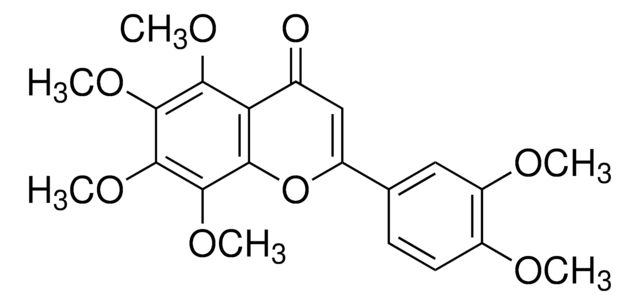SML0953
Cirsiliol
≥90% (HPLC)
Sinónimos:
2-(3,4-Dihydroxyphenyl)-5-hydroxy-6,7-dimethoxy-4H-1-benzopyran-4-one, 3′,4′,5-Trihydroxy-6,7-dimethoxy-flavone, 5,3′,4′-Trihydroxy-6,7-dimethoxyflavone, 6,7-Dimethoxy-5,3′,4′-trihydroxyflavone, 6-Hydroxyluteolin-6,7-dimethyl ether, 6-Methoxyluteolin 7-methyl ether, Crisiliol
About This Item
Productos recomendados
Quality Level
assay
≥90% (HPLC)
form
powder
storage condition
protect from light
color
white to beige
solubility
DMSO: 10 mg/mL, clear
storage temp.
2-8°C
InChI
1S/C17H14O7/c1-22-14-7-13-15(16(21)17(14)23-2)11(20)6-12(24-13)8-3-4-9(18)10(19)5-8/h3-7,18-19,21H,1-2H3
InChI key
IMEYGBIXGJLUIS-UHFFFAOYSA-N
Biochem/physiol Actions
Features and Benefits
signalword
Warning
hcodes
Hazard Classifications
Acute Tox. 4 Oral
Storage Class
11 - Combustible Solids
wgk_germany
WGK 3
flash_point_f
Not applicable
flash_point_c
Not applicable
Certificados de análisis (COA)
Busque Certificados de análisis (COA) introduciendo el número de lote del producto. Los números de lote se encuentran en la etiqueta del producto después de las palabras «Lot» o «Batch»
¿Ya tiene este producto?
Encuentre la documentación para los productos que ha comprado recientemente en la Biblioteca de documentos.
Contenido relacionado
Apoptosis, or programmed cell death (PCD), is a selective process for the removal of unnecessary, infected or transformed cells in various biological systems. As it plays a role in the homeostasis of multicellular organisms, apoptosis is tightly regulated through two principal pathways by a number of regulatory and effector molecules.
Nuestro equipo de científicos tiene experiencia en todas las áreas de investigación: Ciencias de la vida, Ciencia de los materiales, Síntesis química, Cromatografía, Analítica y muchas otras.
Póngase en contacto con el Servicio técnico
